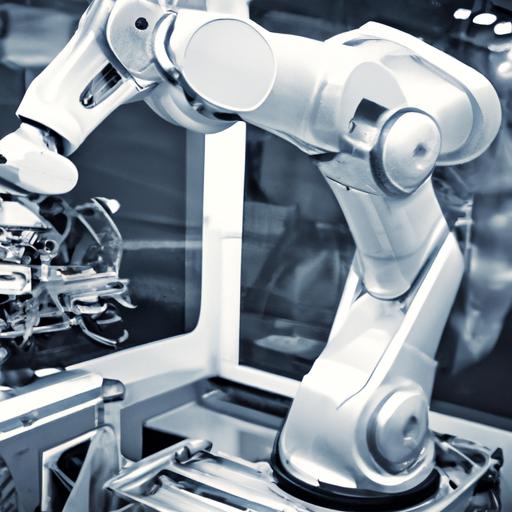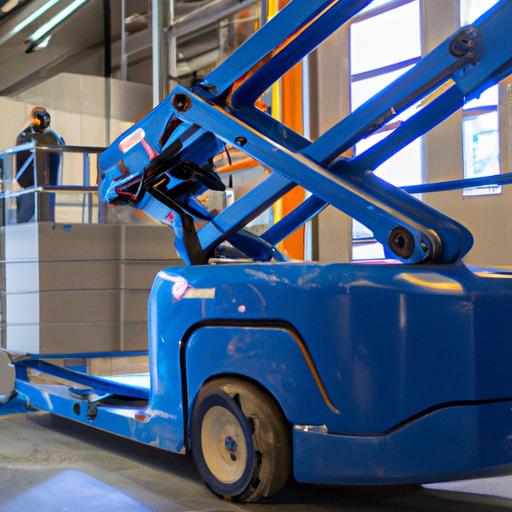Robotics for Production: Revolutionizing Efficiency and Quality
In the rapidly evolving landscape of manufacturing, Robotics for production has emerged as a game-changing technology. But what exactly does it entail? Simply put, robotics for production involves the utilization of automated machines and intelligent systems to streamline manufacturing processes and enhance productivity. This innovative approach has revolutionized the manufacturing industry, offering a plethora of benefits that were previously unimaginable.
Defining Robotics for Production
Robotics for production refers to the integration of intelligent machines, often equipped with artificial intelligence (AI) and machine learning capabilities, into various stages of the manufacturing process. These machines, known as robots, are capable of executing complex tasks with precision, speed, and consistency, thereby reducing human intervention and minimizing errors.
The Importance and Benefits of Incorporating Robotics in Production Processes
The integration of robotics in production processes has become crucial for industries aiming to stay competitive in today’s fast-paced world. By harnessing the power of robotics, companies can unlock a multitude of benefits that significantly impact their bottom line.
First and foremost, robotics for production enhances efficiency. These automated systems can perform repetitive and labor-intensive tasks with unwavering accuracy and at an incredible speed. By freeing human workers from mundane responsibilities, robotics enable them to focus on more strategic and creative aspects of their work, leading to increased productivity and innovation.
Moreover, robotics technology offers unparalleled precision, resulting in improved product quality and consistency. Robots can execute tasks with minimal variation, ensuring uniformity in every unit produced. This not only enhances customer satisfaction but also reduces waste and rework, ultimately saving costs for manufacturers.
The integration of robotics also enhances workplace safety. By taking over hazardous tasks or working alongside human workers, robots minimize the risk of accidents and injuries. This not only protects the well-being of employees but also reduces potential legal liabilities for companies.
In conclusion, the incorporation of robotics in production processes is a transformative step for industries worldwide. From increased efficiency and improved product quality to enhanced workplace safety, the benefits are undeniable. In the following sections, we will delve deeper into the evolution, applications, advantages, challenges, and future outlook of robotics for production. So, let’s embark on an intriguing journey to explore the fascinating world of robotics and its impact on the manufacturing landscape.
Evolution of Robotics in Production
Historical Overview of the Development of Robotics in Production
The journey of robotics in production can be traced back to the early 1960s when the first industrial robot, Unimate, was introduced by George Devol and Joseph Engelberger. Unimate revolutionized the manufacturing industry by automating tasks previously performed by humans, such as welding and material handling. This groundbreaking invention paved the way for further advancements in robotics technology.
In the subsequent decades, robotics in production witnessed remarkable progress. The introduction of computer numerical control (CNC) systems in the 1970s enabled robots to be programmed with precise instructions, enhancing their versatility and adaptability. As technology continued to evolve, robots became more intelligent, capable of sensing and responding to their environment.
Key Milestones and Advancements in Robotics Technology
Over the years, several milestones have propelled robotics in production to unprecedented heights. In the 1980s, the development of articulated robots revolutionized the industry. These robots, equipped with multiple joints and segments, could mimic human movements with greater flexibility and accuracy. This breakthrough led to their widespread adoption in various manufacturing processes.
The 1990s witnessed the emergence of collaborative robots, also known as cobots. These robots were designed to work alongside human workers, assisting them in tasks that required precision, strength, or repetitive actions. Cobots brought a new level of efficiency and safety to production lines, as they could seamlessly collaborate with humans, enhancing productivity and reducing the risk of accidents.
In recent years, advancements in AI and machine learning have propelled robotics technology even further. Robots are now capable of learning from their experiences, adapting to changing conditions, and making intelligent decisions on the factory floor. This has opened up new possibilities for automation, enabling robots to perform complex tasks that were previously deemed impossible.
From the early days of Unimate to the cutting-edge robots of today, the evolution of robotics in production has been nothing short of remarkable. Each milestone and advancement has brought us closer to a future where robotics will play an even more significant role in revolutionizing manufacturing processes. In the following sections, we will explore the diverse applications, advantages, challenges, and future prospects of robotics in production. So, let’s delve deeper into this exciting realm and uncover the potential that awaits us.
Applications of Robotics in Production
In today’s technologically advanced era, robotics has found its place in a wide array of industries, revolutionizing production processes and driving innovation. Let’s explore the diverse applications of robotics in production across various sectors.
1. Automotive Industry
The automotive industry has been at the forefront of employing robotics in production. From assembly lines to paint shops, robots have become an integral part of automobile manufacturing. These versatile machines handle tasks such as welding, painting, and assembly with precision and speed, ensuring seamless production and consistent quality.
One notable example is the Tesla Gigafactory, where robots are utilized for efficient battery production and assembly. These robots contribute to the high production output and the rapid growth of the electric vehicle market.
2. Electronics Manufacturing
Electronics manufacturing is another sector that heavily relies on robotics. With the increasing demand for consumer electronics, robots play a crucial role in ensuring efficient and error-free production. They handle delicate components, perform intricate soldering, and conduct quality control inspections, contributing to the seamless production of electronic devices.
Foxconn, a leading electronics manufacturer, is known for its extensive use of robotics in production. Their factories are equipped with robots that can perform tasks such as screen assembly and testing, contributing to the mass production of devices like smartphones and tablets.
3. Pharmaceutical Industry
The pharmaceutical industry has embraced robotics to improve efficiency and precision in various production processes. Robots are employed in tasks such as dispensing medications, packaging, labeling, and quality control. These machines can handle delicate and potentially hazardous substances, ensuring accuracy and adherence to strict regulations.
An example of robotics in the pharmaceutical industry is the robot-assisted medication dispensing system used in hospitals and pharmacies. These systems accurately measure and dispense medications, reducing the risk of human error and improving patient safety.
4. Food and Beverage Production
Even the food and beverage industry has witnessed the integration of robotics into production processes. Robots are employed in tasks such as packaging, sorting, and quality control. They can handle delicate food items and perform repetitive tasks with precision, ensuring hygiene standards are met and enhancing production efficiency.
For instance, the dairy industry utilizes robotic milking systems that automate the milking process. These systems ensure consistent milking, minimize labor requirements, and improve animal welfare.
The applications of robotics in production extend far beyond these industries, with examples ranging from aerospace manufacturing to textile production. The versatility and adaptability of robotics make them valuable assets in countless sectors, driving efficiency, and pushing the boundaries of what is possible in production processes.
Advantages of Robotics in Production
Increased Productivity and Efficiency
Robots have the remarkable ability to work tirelessly around the clock without experiencing fatigue or the need for breaks. By automating various production tasks, they can significantly increase productivity and throughput. Unlike human workers, robots do not require rest, resulting in uninterrupted operations and optimized production schedules. This translates into faster turnaround times, shorter lead times, and increased output capacity for manufacturers.
Reduction in Production Costs
Integrating robotics into production processes can bring about substantial cost savings for companies. While the initial investment in robotics technology may seem significant, the long-term benefits outweigh the upfront expenses. Robots can perform tasks with high precision and accuracy, minimizing material waste and reducing the need for rework. Additionally, the consistent performance of robots ensures efficient resource utilization, resulting in optimized energy consumption and decreased operational costs.
Improved Product Quality and Consistency
One of the standout advantages of robotics in production is the assurance of superior product quality and consistency. Robots execute tasks with unwavering precision, eliminating human errors and variations in output. This consistency ensures that each product meets the specified standards and adheres to strict quality control measures. As a result, manufacturers can deliver products that consistently meet or exceed customer expectations, enhancing brand reputation and customer loyalty.
Enhanced Workplace Safety
Safety is a top priority in any manufacturing environment, and robotics plays a significant role in improving workplace safety. By automating hazardous or physically demanding tasks, robots reduce the risk of injuries to human workers. They can handle tasks in environments with extreme temperatures, toxic substances, or high-risk conditions, ensuring the safety and well-being of employees. With robots taking on dangerous tasks, human workers can be redeployed to more complex and value-added responsibilities, further enhancing overall workplace safety.
In conclusion, the advantages of incorporating robotics in production are undeniable. From increased productivity and reduced costs to improved product quality and enhanced workplace safety, the impact is far-reaching. The next section will explore the challenges and limitations that companies may face when integrating robotics into their production processes. Let’s dive deeper into this intriguing topic.
Challenges and Limitations of Robotics in Production
While robotics for production offers numerous advantages, it is not without its challenges and limitations. It is essential to consider these factors to ensure effective implementation and address potential concerns. Let’s explore some of the key challenges associated with robotics in production.
1. Cost of Implementation and Maintenance
One of the primary challenges is the initial investment required for implementing robotics in production processes. The cost of acquiring and integrating robotic systems can be substantial, especially for small and medium-sized enterprises. Additionally, ongoing maintenance expenses, software updates, and repairs can further add to the financial burden. However, it is important to note that the long-term benefits often outweigh the initial costs, making it a worthwhile investment for many companies.
2. Need for Skilled Personnel for Programming and Maintenance
Another challenge is the need for skilled personnel to operate, program, and maintain the robotic systems. As the technology evolves, there is a growing demand for individuals with expertise in robotics and automation. Companies need to invest in training programs to ensure their workforce has the necessary skills to effectively utilize and maintain the robotic systems. This requirement for skilled personnel may pose a challenge, particularly for organizations operating in regions with a shortage of qualified professionals.
3. Potential Job Displacement and Workforce Concerns
The integration of robotics in production processes has raised concerns about potential job displacement. As robots take over repetitive and manual tasks, there is a valid apprehension about the impact on human jobs. While it is true that certain job roles may be replaced or transformed, it is important to recognize that robotics also creates new opportunities. Collaborative work environments, where humans and robots work together, can lead to the creation of new roles that require advanced skills and expertise.
4. Technical Limitations and Potential Risks
Despite advancements in robotics technology, there are still certain technical limitations and potential risks to consider. Robots may not be suitable or cost-effective for every task in the production process. Certain intricate or delicate operations may require human intervention due to the limitations of robotic systems. Additionally, there are potential risks associated with system malfunctions, cybersecurity threats, and ethical considerations. It is crucial to address these risks through robust safety measures, regular system monitoring, and adherence to ethical guidelines.
In conclusion, while robotics for production offers tremendous potential, it is essential to acknowledge and address the challenges and limitations associated with its implementation. By carefully considering factors such as cost, skilled personnel, job displacement concerns, and technical limitations, companies can navigate these challenges effectively and harness the full potential of robotics in production processes.
Future Outlook for Robotics in Production
As technology continues to advance at an unprecedented pace, the future of robotics in production holds immense potential. The impact of robotics on the manufacturing landscape is expected to grow exponentially in the coming years, shaping the way industries operate and revolutionizing production processes.
Emerging Trends and Technologies in Robotics for Production
One of the key trends that will shape the future of robotics in production is the convergence of robotics with other cutting-edge technologies. For instance, the integration of robotics with Internet of Things (IoT) technology enables real-time data exchange, allowing robots to adapt and optimize their performance based on changing conditions. This seamless connectivity between machines and systems unlocks new possibilities for automation and efficiency.
Another emerging technology in the field of robotics is collaborative robotics, often referred to as cobots. These robots are designed to work alongside human workers, enhancing their capabilities rather than replacing them. Cobots can handle complex tasks requiring dexterity and decision-making, while humans oversee and guide their operations. This collaboration between humans and robots maximizes productivity and opens up new avenues for innovation.
Potential Impact on the Job Market and Workforce
The rise of robotics in production has sparked concerns about the potential displacement of human workers. While it is true that some tasks previously performed by humans may be automated, the introduction of robotics also creates new job opportunities. Industries will require skilled professionals to develop, program, and maintain robotics systems, ensuring their seamless integration into production processes.
Moreover, the presence of robotics in production streamlines operations, allowing companies to reallocate human resources to more value-added tasks. This shift can lead to upskilling and reskilling of the workforce, enabling employees to take on higher-level responsibilities and contribute to innovation and strategic decision-making.
Predictions for Future Advancements and Market Growth
The future of robotics in production is poised for remarkable growth. According to market research, the global industrial robotics market is projected to reach a value of $80 billion by 2027. This growth can be attributed to the continuous advancements in robotics technology, making it more affordable, versatile, and accessible to industries of all sizes.
Furthermore, the adoption of robotics in new sectors and industries is expected to expand. From healthcare and logistics to agriculture and construction, robotics has the potential to revolutionize various domains, improving efficiency, safety, and productivity.
In conclusion, the future of robotics in production holds great promise. The integration of emerging technologies, the collaboration between humans and robots, and the potential for job market transformation all point towards a dynamic and evolving landscape. As industries embrace the power of robotics, they will unlock new levels of efficiency, quality, and innovation, propelling the manufacturing sector into new frontiers of success. So, buckle up and get ready to witness the transformative journey of robotics in production!






